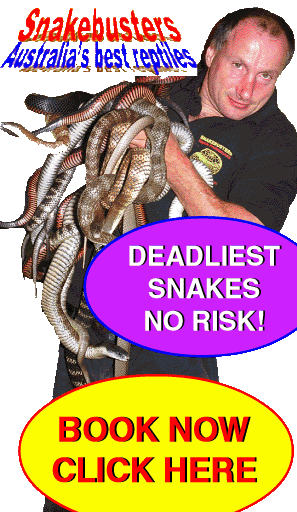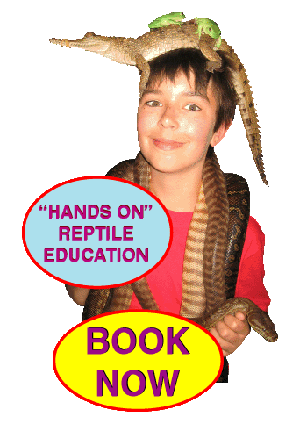

Best (most immaculately healthy) reptiles.
These days (1990 onwards) most experienced reptile people tend
to keep their reptiles alive and more-or-less healthy.
Reptiles are generally well-known and their husbandry is no longer a mystery.
Notwithstanding this, there is a difference between making reptiles survive
and making them thrive.
All reptiles kept by Raymond Hoser (Snakebusters) are subjected to the
best practice keeping methods, many of which were pioneered by Raymond
Hoser.
As a measure of the superiority of his keeping and husbandry methods, in
2003 Hoser was the first to identify in his collection a previously unknown
reovirus that affected most of his snakes. This same virus had gone through
numerous collections undetected causing deaths in snakes in what were often
mass die offs. The Hoser die off was stopped at the time of the second
death (total losses four after another week) and Raymond then developed
a treatment which saved several other snakes that would have died and has
since been used to successfully treat other affected reptiles both in Raymond
Hoser's and other collections.
The first known source of the reovirus was the Australian Reptile Park
in NSW, who in turn passed the virus on to other collections (at first
unaware of the virus) and so on, with almost all collections suffering
heavy losses. The full story of the reovius is found in a paper published
in 2003 at: http://www.herp.net.
No other affected collection (or keeper) were aware of the reovirus or
their being affected until after Raymond Hoser correctly identified the
cause of ailment in his collection and then accurately tracked the virus
back through other collections and again downline from then to collections
in various parts of Australia. Most of these collections had suffered heavy
losses from unknown causes.
The significance of this story is to show the proactive and intellectually
rigorous keeping methods engaged by Raymond Hoser and the strong no-deaths
policy being enforced.
All snakes and lizards kept by Raymond Hoser/snakebusters are regularly
examined for all known ailments and any signs of ill-health. All incoming reptiles are given
"shotgun" treatment for internal and external parasites, the
treatment of which is effective against almost all known parasites that
affect reptiles. Feces are regularly examined and in the rare occasions
that feces or anything else is not as it should be, proactive diagnosis
and treatment (if necessary) is commenced.
Few other keepers have such a rigid keeping regime.
The result is immaculately healthy reptiles and reptiles that will breed
on cue if so desired.
Reptiles are only used in shows if they are in immaculate condition and
are generally well-adjusted and used to being handled, which as a rule includes all we have.
HOUSING
The snakebusters facility is on a large 2/3 acre site in Melbourne's East. Our reptiles are not housed in naturalistic surroundings like that experienced by wild reptiles. Our facility is not a zoo open to the public and does not claim to be. In fact, we do not claim to be a "zoo" in any sense of the word. We are not subjected to the constraints of zoos in that we have to make cages "look nice" for the general public. Instead our housing is state-of-the-art and designed solely for the benefit of the reptiles and their management. This is seen in plastic tub style cages that look sparse, but are designed to maintain optimal hygiene, minimal risk of disease, total access to reptiles on call and ability to monitor all reptiles as needed and with minimal stress to the reptiles.
Contrary to popular belief, wild reptiles are not neccessarily well-off or happy and as a rule mortality is high. The same tends to apply to reptiles housed in naturalistic environments and when there is more than one animal per cage. The Snakebusters reptiles are housed in their own air-conditioned three room building in a manner that enables their health and welfare to be vastly superior to anything seen in wild reptiles. The reptiles are housed in better conditions than ever seen in the wild. The reptiles have vastly superior food than what they usually get in the wild in terms of nutritional value. The reptiles are also subjected to less day-to-day stress than their wild counterparts (the biggest stress factor for most reptiles is actually other reptiles!). As a rule, each reptile is generally housed on it's own (reducing reptile-reptile stress) in it's own climatically controlled cage with fully automated systems controlling the temperature of each cage or part thereof on a 24 hour basis. Likewise for each room of the building, providing the reptiles with optimal temperatures for health, breeding and doing shows, regardless of how hot or cold the weather is outside! When working reptiles continually (day after day for weeks on end), we may reverse the day/night cycle to enable feeding and other activity to continue uninterrupted, although this is not noticeable to persons seeing reptiles being shown, save for a reduced rate of defecation during shows. Breeding in reptiles works on an annual cycle and is maintained via our climate and cage control systems. We can push the annual cycle down to about 7 months or up to about 18 months if desired, but generally run on a 12 month cycle that runs about 3 months ahead of the wild (Melbourne) state (for wild reptiles). As a rule we breed all adult reptiles we hold either annually or biannually. For example in 2005/2006 we bred all our venomous species for which we had adult pairs (Black, Brown, Tiger, Death Adder), save for the Copperheads which we held off due to the fact that the female we were targetting for breeding had to be put on anti-biotics for a short period (following removal of a cyst) and these drugs adversely impact on developing young. The Copperheads bred the following year!
WHY SO CLEAN?
People associate animals with smells and the like. This includes reptiles, in that where there are reptiles, you usually see breeding rodents, insects and the like. This isn't the case for Snakebusters at our facility. We do not breed rodents, insects or any other food animal. Instead our reptiles are fed frozen rodents and other food brought in. In fact most of our snakes feed principally on raw chicken necks, which are far superior in nutritional value to rodents and considerably cheaper. People accustomed to the idea that snakes only eat "live natural food" often get a rude shock when confronted with dozens of our snakes woofing down chicken necks as fast as they can be given to them. Our non-snake reptiles have different diets, but none is bred on site.
RESEARCH
The snakebusters reptiles are also subject of intensive research. Each animal has it's own file and while most research fits the basic genre of observational, this is within the parameters set in terms of keeping (housing), diet, interactions with other reptiles of same or other species and other factors. The results are seen as published in peer-reviewed scientific journals (e.g. Herpetofauna, Victorian Naturalist, etc), the popular literature and even media such as TV, radio and newspapers.



Non-urgent email inquiries via the Snakebusters bookings page at:
http://www.snakebusters.com.au/sbsboo1.htm
Urgent inquiries and bookings please phone:
Melbourne, Victoria, Australia:
(03) 9812 3322 or 0412 777 211
